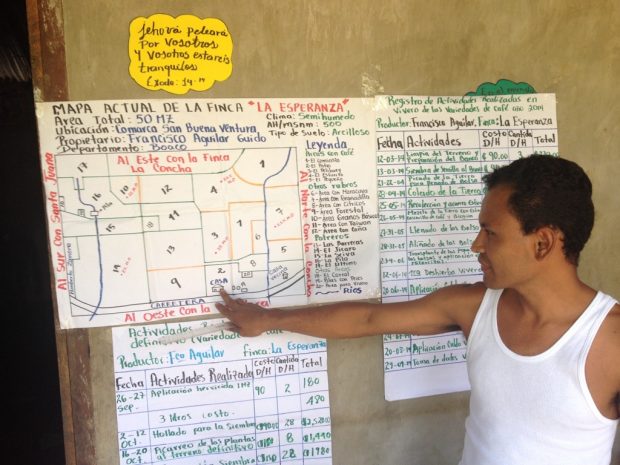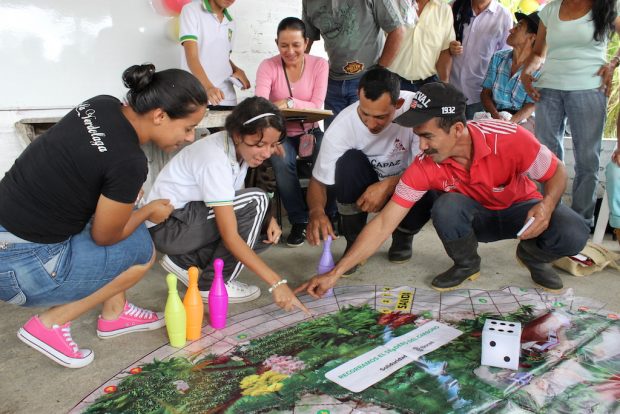
From the Nicaragua project managed by Twin in partnership with CAFENICA . All images courtesy of Twin.
It seems like every few weeks there is a scary news story out about coffee and climate change. The coffee sector is now waking up to this threat, with many coffee brands already supporting climate-smart agri-projects. But is better farming all it takes?
At Twin, a UK-based development-through-trade NGO, we believe we need to look beyond the farm gate to truly meet the challenge of climate change. It’s about more than introducing new practices or technologies; coffee communities themselves need to be resilient to climate change.
What does resilience even mean?
For the uninitiated, resilience has a few definitions, but broadly speaking it’s the ability to plan for, cope with, and recover from climate shocks. We looked at other coffee initiatives to see how they interpret the concept of resilience and found it was often little more than a buzz phrase; poorly defined in project plans and falling away entirely during implementation.
Although we managed to identify lots of coffee and climate projects during our search (check out our map of projects), we found very little learning or sharing going on between them. To help join the dots, our new report, called “Coffee and climate change: moving from adaptation to resilience,” offers practical advice for NGOs and businesses.
We partnered with UTZ and Solidaridad to look in detail at four projects from start to finish — how they came about, how they were managed, and how success was measured. To get a diverse snapshot, we looked at two Twin projects in Uganda and Nicaragua, an UTZ project in Vietnam, and a Solidaridad project in Colombia.

From the Western Uganda project managed by Twin in partnership with the Bukonzo Joint Cooperative Union.
We found that resilience-building highlights the links between social and economic development and brings a deeper understanding of the complexities that exist in communities. People tend to think of resilience as a problem solved at origin, but it is about more than just better farming — it has socio-economic aspects, too.
Value chain partnerships
Resilience for coffee communities means long-term commitment from customers, which helps them through difficult times and enables them to invest in the future. Farmers, traders, exporters, roasters, brands and consumers therefore all have a stake in resilience and can be part of the solution. Partnering along the value chain aligns interests and facilitates open communication.
Twin’s bean-to cup-partnership with M&S is a great example of a privately funded initiative that brings together talent from throughout the sector. To help secure the water supply at the San Juan coffee cooperative in Peru, Twin and our coffee business, Twin Trading, teamed up with roasters Matthew Algie and M&S stores. The whole value chain now shares in the risks, costs and rewards of the project.
Resilience in action
In the projects looked at, examples of resilience included information sharing, women’s empowerment, engaging young farmers, and group saving initiatives. In Uganda, farmers attending field schools self-organized into smaller groups to share and discuss ideas. This aided communication and helped build community cohesion.
In Colombia, family friendly meetings featuring puppet shows and games helped to introduce the next generation to the industry. The sessions welcomed both men and women and encouraged gender equity in training.
Tips for NGOs
Engage the community from the beginning to ensure the focus of the project addresses their priorities. NGOs should help producer organizations develop climate strategies for the long-term, rather than being constrained by project timeframes. Ensure women and men are both invited to trainings, and have sensitive timings and locations to ensure women can attend.
For projects using farmer field schools, be sure to inspire interest — let farmers experiment and innovate, don’t just demonstrate. Measure success not just by counting how many practices have been adopted, but by finding out what farmers have learned. In general, M&E in climate projects should focus on processes, not results, as these are hard to measure. Make data collection participatory to optimize the process.
Ideas for businesses
Sourcing strategies should be integral to your overall sustainability agenda. Too often, CSR teams and buyers sit in different buildings. They should work hand in hand. Bridging this gap ensures commercial viability of projects and can also help engage consumers. Get to know the needs of all actors in the value chain. At, origin this means doing a risk assessment. On a global scale, businesses need to collaborate more. Get active in industry initiatives and platforms to share your learning and avoid duplicating mistakes.
With coffee prices volatile and production costs rising, climate action will only be worthwhile for smallholder farmers — who provide the backbone of the coffee industry — if they can see a future for themselves in coffee. It’s time for NGOs and businesses to look beyond climate smart agriculture to issues such as gender equity and commitment along the supply chain in order to meet the challenge of climate change head on.
(Editor’s note: This column is was in response to DCN’s request to Twin to help summarize its recent 39-page report on numerous case studies on climate change initiative in coffee-growing communities. See the full report here.)
Xavier Hamon
Xavier Hamon is the Coffee Program Manager for the London-based NGO Twin. He specializes in climate change adaptation for coffee producer organizations in East Africa and Latin America.








Comment